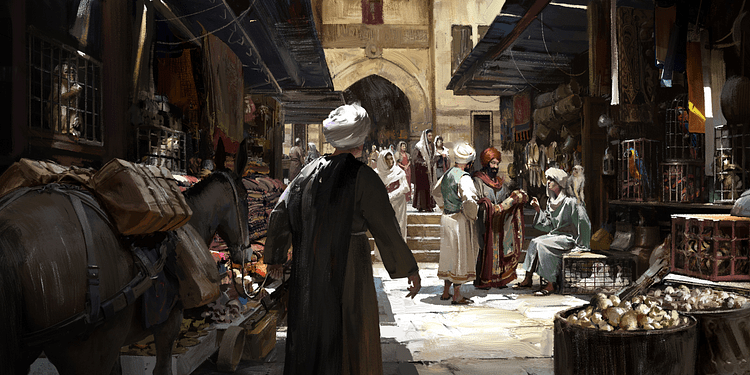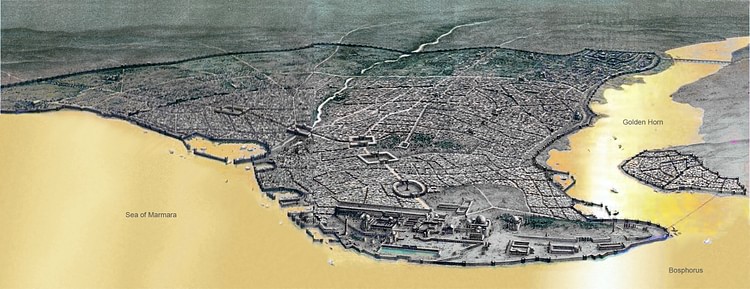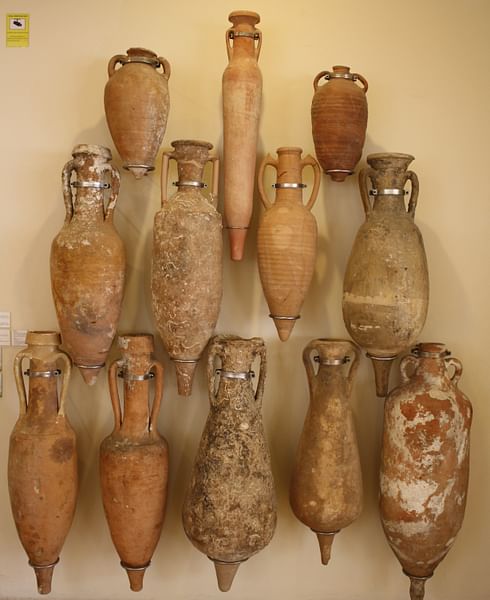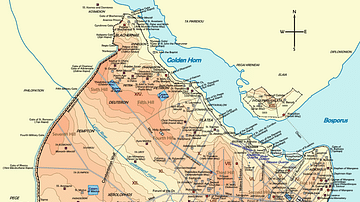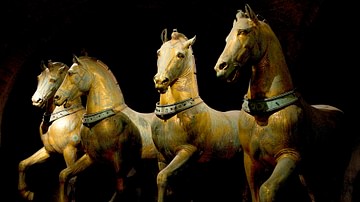Trade and commerce were essential components of the success and expansion of the Byzantine Empire. Trade was carried out by ship over vast distances, although for safety, most sailing vessels were restricted to the better weather conditions between April and October. On land, the old Roman road system was put to good use, and so by these two means goods travelled from one end of the empire to the other, as well as from far-away places such as modern-day Afghanistan, Russia, and Ethiopia. The bigger cities had thriving cosmopolitan markets, and Constantinople became one of the largest trading hubs in the world where shoppers could stroll down covered streets and pick up anything from Bulgarian linen to Arabian perfumes.
Attitudes to Trade
The attitude to trade and commerce in the Byzantine Empire had changed very little since antiquity and the days of ancient Greece and Rome: the activity was not regarded highly and considered a little undignified for the general landed aristocrat to pursue. For example, emperor Theophilos (r. 829-842 CE) famously burned an entire ship and its cargo when he found out that his wife Theodora had been dabbling in commerce and had financial connections with the vessel. This attitude may explain why Byzantine chroniclers often avoid the subject entirely. Indeed, in Byzantine art and literature, traders, merchants, bankers and money-lenders who had tried to cheat their clients were often portrayed as inhabiting the lower levels of Hell.
There was also a general mistrust of traders and entrepreneurs (who could be both men and women) by both the general populace and the authorities. Emperors, therefore, were often particular in enforcing such matters as the standardisation of weights and measures, and, of course, prices. Heavy goods were scrupulously weighed using steelyards and weights in the form of a bust of either the emperor or the goddess Minerva/Athena. Smaller goods such as spices were measured out using a balance with weights made of copper-alloy or glass. To minimise cheating, weights were inscribed with their representative weight or equivalent value in gold coinage and regularly checked.
State Involvement
Perhaps because of these attitudes to trade as a slightly less than respectable profession, the state was much more involved in it than might be expected. Unlike in earlier times, the state played a greater role in trade and the provisioning of major cities, for example, which was rarely left to private traders. Trade operated through a variety of hereditary guilds with merchants who transported the goods (navicularii) being subsidised by the state and subject to significantly reduced duties and tolls. Duty on imported goods was collected by state-appointed officials known as kommerkiarioi who collected duties on all commercial transactions and who issued an official lead seal once goods had been through the system. To limit the possibilities for corruption, the kommerkiarioi were given one-year posts and then moved elsewhere.
Customs stations were dotted along the frontiers and major ports of the empire with two of the most important being at Abydos and Hieron, which controlled the Straits between the Black Sea and the Dardanelles. There must have been a good deal of smuggling but measures were taken to counter it such as a 6th-century CE treaty between the Byzantines and Sassanids which stipulated that all traded goods must pass through official customs posts. Records were scrupulously kept, too, most famously the Book of the Prefect in Constantinople, which also outlined the rules for trade and trade guilds in the city.
Other examples of state intervention in trade include the provision made for loss or damage to goods transported by sea. The Rhodian Sea Law (7th or 8th century CE) stipulated that, in such a case, merchants received a fixed compensation. The state also ensured that no goods useful to an enemy were permitted to be exported - gold, salt, timber for ships, iron for weapons, and Greek Fire (the secret Byzantine weapon of highly inflammable liquid). Neither was the prestigious silk dyed with Tyrian purple permitted for sale abroad.
Another area of close state supervision was, of course, coinage. Copper, silver, and gold coins were minted and issued carrying images of emperors, their heirs, the Cross, Jesus Christ, or other images related to the Church. Although the state minted coins primarily for the purpose of paying armies and officials, the coinage did filter down and through all levels of society. Coinage - in the form of the standard gold nomisma (solidus) coin - was also necessary to pay one's annual taxes. When there were fewer wars and so fewer soldiers and suppliers to pay for or when the tentacles of the local state bureaucracy declined in the 7th and 8th century CE, coins could become scarce and barter had to be resorted to in the provinces, especially.
Byzantine state control of trade was hit by the Arab conquests from the 7th century CE. Cities, too, were in decline and ever-more self-sufficient while shipping became increasingly the domain of private traders. When a greater stability in the Mediterranean allowed for a resurgence in wider trade networks from the 10th century CE, it would be the Italian states which seized the opportunity to reap profit from the transport and sale of goods from one end of the known world to the other. Great merchants such as the Venetians were even given their own facilities and preferential regulations and duties at Constantinople. At first, this was in return for naval aid in Byzantine wars, but steadily the presence of Italian merchants (from Amalfi, Pisa, Genoa, and Venice) on the wharfs of the capital would become a permanent fixture. Constantinople, thus, could boast the most vibrant market in Europe with merchants from Syria, Russia, Arabia and many other places forming a semi-permanent cosmopolitan residency. Quarters sprang up in the city where Jews built synagogues, Arabs built mosques, and Christians their churches.
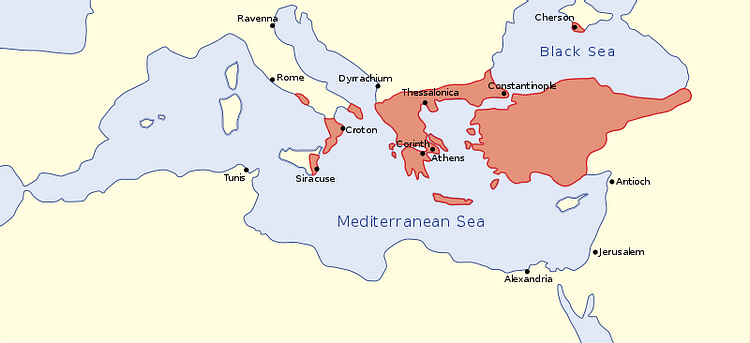
Traded Goods
The great traded goods of antiquity continued to be the most commonly shipped in the Byzantine Empire of the medieval period: olive oil, wine, wheat, honey, and fish sauce. Likewise, the terracotta amphora remained the storage vessel of choice. The design of amphorae changed depending on the location of their manufacture, although handles became significantly bigger from the 10th century CE. The contents were carefully labelled with either stamped inscriptions on the sides or clay tags added. Byzantine amphorae have been found across the Mediterranean and in ancient Britain, the Black Sea, the Red Sea, and the Arabian Sea areas. Not until the 12th century CE would the amphorae be challenged and surpassed in use by the wooden barrel.
Other goods which were traded between regions included cattle, sheep, pigs, bacon, vegetables, fruit, pepper and other spices, medicines, incense, perfumes, soap, wax, timber, metals, worked gemstones, lapis lazuli (from Afghanistan), glass, ivory (from India and Africa), worked bone, flax, wool, textiles, linen (from Bulgaria), fur (from Russia), silver plate, enamels, amber (from the Baltic), bronze vessels, and brass goods (especially buckets and decorated doors panels largely destined for Italy). The slave trade, with slaves often supplied from Russia, continued to be important, too.
Pottery tableware was another common part of any ship's cargo as indicated by shipwrecks. Slipped red-bodied ceramics with stamped or applied decoration were common until the 7th century CE and then slowly replaced by finer wares which were lead-glazed, white-bodied and then red-bodied from the 9th century CE. Decoration, when present, was impressed, incised, or painted. Constantinople was a major production centre for white-bodied ceramics and Corinth produced a large quantity of red-wares from the 11th century CE.
Silk was first introduced from China but imported raw silk was eventually replaced by silk produced on mulberry farms (the food of the silkworm) in Phoenicia and then Constantinople from 568 CE. The silk factory at the Byzantine capital was under imperial control, and the five silk guilds were under the auspices of the Imperial Prefect of the city. Other notable silk-producing sites within the empire included southern Italy, Greek Thebes and Corinth.
Marble was always in demand across the empire as it was used by those who could afford it for buildings, flooring, church altars, decoration, and furniture. The basic grey-white marble which became the staple of any Byzantine architect's project was quarried in large quantities from the island of Proconnesus in the Sea of Marmara (up to the 7th century CE) while more exotic marble came from Greece, Bithynia and Phrygia. Shipwrecks provide evidence that marble was worked before it was shipped to its final destination. Many ancient monuments, especially pagan ones, across the Mediterranean were also plundered for whatever useful marble bits and pieces could be reused and shipped elsewhere. Cyzicus in the Sea of Marmara became a noted centre of marble production and recycling from the 8th century CE.
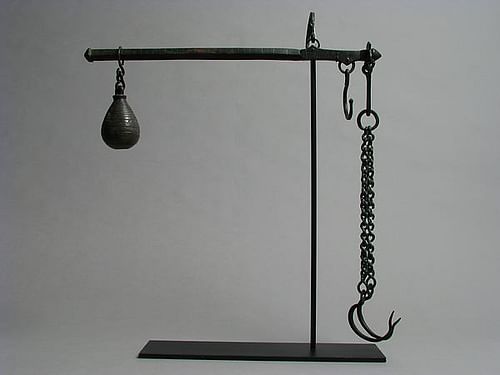
Markets & Shops
Ordinary citizens could purchase goods in markets which were held in dedicated squares or in the rows of permanent shops which lined the streets of larger towns and cities. Shops usually had two floors - one on street level where the goods were manufactured, stocked and sold, and a second floor where the shopkeeper or artisan and their family lived. Shoppers were protected from the sun and rain in such streets by collonaded roofed walkways, which were often paved with marble slabs and mosaics. Some shopping streets were pedestrianised and blocked to wheeled traffic by large steps at either end. In some cities, the shopkeepers were expected to maintain lamps outside their shops to provide street lighting. Just as today, shopkeepers tried to spread their wares out as far as possible to catch the casual shopper, and there are imperial records complaining about the practice.
